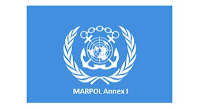This regulation comes under MARPOL Annex I, chapter 4 - Requirements for the Cargo Area of Oil Tankers, Part C - Control of Discharge of Oil, Regulation 34.
General Requirements:
- Any discharge into the Sea of oil or oily mixture from the cargo area of an oil tanker shall be prohibited.
- Whenever any visible traces of oil are observed on or below the surface of the water near a ship or its wake, the Governments of parties should promptly investigate the facts bearing on the issue of whether there has been a violation of the provisions of this regulation.
- The investigation should include, in particular, the wind and sea conditions, the track and speed of the ship, other possible sources of the visible traces in the vicinity and any relevant oil discharge records.
- No discharge into the sea shall contain chemicals or other substances in quantities or concentrations which are hazardous to the marine environment to circumvent the conditions of discharge specified in the regulation.
- The oil residue which cannot be discharged into the sea in compliance with this regulation shall be retained on board for subsequent discharge to reception facilities.
Discharges outside special Areas except in Arctic waters:
- Any discharge into the sea of oil or oily mixture from the cargo area of an oil tanker, shall be prohibited except when all the following conditions are satisfied:
- The tanker is not within a Special area.
- The tanker is more than 50 nautical miles from the nearest land.
- The tanker is proceeding en route.
- The instantaneous rate of discharge of oil content does not exceed 30 litres per nautical miles.
- The total quantity of oil discharged into the sea does not exceed 1/15,000 of the total quantity of the particular cargo of which the residue formed a part (for tankers delivered on or before 31 December 1979).
- The total quantity of oil discharged into the sea does not exceed 1/30,000 of the total quantity of the particular cargo of which the residue formed a part (for tankers delivered after 31 December 1979).
- The tanker has an oil discharge monitoring and control system in operation and a slop tank arrangement as required by this Annex.
- The above-mentioned discharge criteria shall not apply to the discharge of clean or segregated ballast.
Discharges in special Areas:
- Any discharge into the sea of oil or oily mixture from the cargo area of an oil tanker shall be prohibited while in Special Area.
- This regulation shall not apply to the discharge of clean or segregated ballast.
- Nothing in this regulation shall prohibit a ship on the voyage only part of which is in a special area from discharging outside the special area in accordance with the requirements of this regulation.
Requirements for oil tankers of less than 150 grass tonnage:
- The requirements of the regulation on Slop tank, ODMCS and oil/water interface detector of this Annex shall not apply to Oil tankers less than 150 gross tonnages, for which the control of discharge of oil under this regulation shall be effected by the retention of oil on board with the subsequent discharge of all contaminated washings to reception facilities.
- The total quantity of oil and water used for washing and returned to a storage tank shall be discharged to reception facilities unless adequate arrangements are made to ensure that any effluent which is allowed to discharge into the sea is effectively monitored to ensure that that provisions of this regulation are complied with.
To download this article click the button given below👇
Reference: IMO Publications & Documents - International Conventions - MARPOL - Annex I







0 Comments
Thanks for your Valuable comments and Suggestions